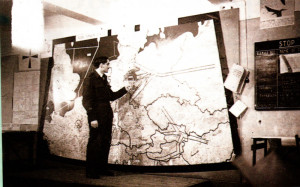
How I enjoyed the article ‘Going Cheap’, especially the reference to the Berlin Airlift of 1948.
As the wife of an aircrew member, on the outside looking in, I feel that I was very much involved in the Airlift. My husband was a Navigator with 27 Squadron, a Dakota Squadron of RAF Transport Command, based at RAF Oakington, near Cambridge.
We were married on April 22 1948, and duly set off on honeymoon to Eastbourne. Two days later my husband was recalled to Oakington when the Squadron – all eight aircraft – was sent off unexpectedly on a two-month camp to Schleswig, Germany.
After this, at the beginning of July, we decided to try a second honeymoon, at Bournemouth. This time it was even worse because all leave was cancelled and we never even got there. The Berlin Airlift had begun, and my husband recorded in his log book: “Positioning at Wunsdorf for
Operation Carter-Patterson”.
Stranded in Cambridge, I decided to apply for the post of Head Teacher of Longstanton School, in a village just a mile down the road from RAF Oakington. Although I was only 22 at the time, unbelievably 1 got the job and – wonder of wonders -there was a school house that went with it.
In August 1948, as my husband arrived back at Oakington, I was installed in the house. Curtains up, carpet down, minimum furniture, no electricity, candles at the ready – but never mind, we had a house, a base, and there I stayed for the duration of the Airlift and beyond.

As the Airlift became more organised a four-dav rest period every 14 days was evolved, but this included two days of travelling backwards and forwards to Germany.
Living so close to the camp, we often put up Commonwealth crews, mainly South African, as travel arrangements from the base were, to say the least, sparse.
There was never any mention of the hazards posed by Russian aircraft which I’ve read about since, nor of the long hours flying, poor food and conditions. As winter approached, and my husband’s four days were due, I remember looking for signs of lifting fog, and listening for the steady drone of the Dakota engines coming in to land – on one occasion hoping that the four days would coincide with the Mess Ball, and the chance of a night out.
Sadly my husband died a few years ago, but those early days of our married life were so interwoven with the events of the Berlin Airlift that I’ve never forgotten them. I am a
member of the British Berlin Airlift Association, and on June 26 I shall be flying out to Berlin to take part in a series of commemorative events being held there.
I feel it is important that events of this kind are recalled and brought to the attention of the younger generation. What a different story would have evolved if this bridge into Berlin had not been built.
As I write, I look up on my wall to see the commemorative plaque that my husband brought back from Germany all those years ago.
My best wishes to Best of British.
Isabel Hughes








